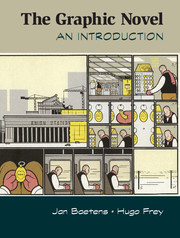Book contents
- Frontmatter
- Contents
- List of illustrations
- Acknowledgments
- 1 Introduction: The Graphic Novel, a Special Type of Comics
- Part One Historical Context
- Part Two Forms
- 5 Understanding Panel and Page Layouts
- 6 Drawing and Style, Word and Image
- 7 The Graphic Novel as a Specific Form of Storytelling
- Part Three Themes
- Notes
- Index
7 - The Graphic Novel as a Specific Form of Storytelling
Published online by Cambridge University Press: 05 October 2014
- Frontmatter
- Contents
- List of illustrations
- Acknowledgments
- 1 Introduction: The Graphic Novel, a Special Type of Comics
- Part One Historical Context
- Part Two Forms
- 5 Understanding Panel and Page Layouts
- 6 Drawing and Style, Word and Image
- 7 The Graphic Novel as a Specific Form of Storytelling
- Part Three Themes
- Notes
- Index
Summary
There exist as many theories on storytelling as there are ideas about the novel itself. And the (rhetorical) definition of narrative by James Phelan as “someone telling someone else on some occasion and for some purpose that something happened” remains, in all its abstract generality, one of the soundest statements ever on what storytelling actually means. However, in this chapter we will not go into a complex discussion of what words such as “narrative” or “novel” signify, but emphasize instead medium-specific aspects of storytelling in the graphic novel. In other words, this chapter focuses on what is particular about the graphic novel as a storytelling device and what makes it different from a novel or from a film, even if in some regards one may recognize some similarities.
It would be absurd indeed to deny that stories are everywhere. Nobody has ever doubted Roland Barthes’s claim: “There are countless forms of narrative in the world.... Moreover, in this infinite variety of forms, it is present at all times, in all places, in all societies.” But we maintain that a story in graphic novel format is more than just a story told in graphic novel format: the choice of the medium induces a set of possibilities as well as impossibilities, of obstacles as well as chances, that are not found in other media, even if it remains always possible to retell or remake a given story in a different medium. The recent love affair between Hollywood and superhero comics and the growing number of experiments in retelling graphic novels across media – as, for instance, in the film versions of American Splendor (2003, Shari Springer Berman and Robert Pulcini) and Ghost World (2001, Terry Zwigoff) or the animated cartoon version of Persepolis (2007, Marjane Satrapi and Vincent Paronnaud) – display some of the opportunities and dangers that characterize these kinds of adaptation. And, of course, the process can go the other way around as well: comics and graphic novels can adapt stories that have already been told in other media, such as City of Glass, David Mazzucchelli’s 1994 reinterpretation of Paul Auster’s 1985 novel; Waltz with Bashir, Ari Folman’s (and David Polonsky, 2009) graphic novel version of his own 2008 movie; and the Escapist series, built in 2004 as an homage to the character invented by Michael Chabon in his novel The Amazing Adventures of Kavalier and Clay (2000).
- Type
- Chapter
- Information
- The Graphic NovelAn Introduction, pp. 162 - 188Publisher: Cambridge University PressPrint publication year: 2014



